Molecular epidemiology of drug-resistant Plasmodium falciparum in Benguela province, Angola
- PMID: 25889865
- PMCID: PMC4374507
- DOI: 10.1186/s12936-015-0634-2
Molecular epidemiology of drug-resistant Plasmodium falciparum in Benguela province, Angola
Abstract
Background: The malaria situation has been worsening in Angola, partly due to armed conflict until the recent past and drug-resistant Plasmodium falciparum. Malaria transmission is heterogeneous within the country, and data on drug-resistant malaria in different parts of the country are incomplete. The aim of the present study was to evaluate resistance to 4-aminoquinolines and antifolate drugs in P. falciparum isolates collected in Benguela province, central Angola, using molecular markers.
Methods: Fingerprick capillary blood was collected from asymptomatic children aged less than 15 years old during a household survey in and around Balombo town in 2010-2011. Samples were screened for P. falciparum by nested PCR. Molecular markers (P. falciparum dihydrofolate reductase [pfdhfr], P. falciparum dihydropteroate synthase [pfdhps], P. falciparum chloroquine resistance transporter [pfcrt], and P. falciparum multidrug-resistance gene 1 [pfmdr1]) were sequenced to determine the key codons associated with drug resistance.
Results: A total of 60 blood samples were positive for P. falciparum. Most isolates with successful PCR amplification had mutant pfdhfr alleles, with either double mutant AICNI (69%) or triple mutant AIRNI (21%) haplotypes. A16V, S108T, and I164L substitutions were not found. Many of the isolates were carriers of either SGKAA (60%) or AGKAA (27%) pfdhps haplotype. K540E substitution was absent. There were only two pfcrt haplotypes: wild-type CVMNK (11%) and mutant CVIET (89%). Wild-type pfmdr1 NYSND haplotype was found in 19% of the isolates, whereas single mutant pfmdr1 YYSND and NFSND haplotypes occurred in 48% and 11%, respectively. Double mutant pfmdr1 haplotypes (YFSND and YYSNY) occurred rarely.
Conclusions: The results suggest that the high prevalence of mutant pfcrt CVIET haplotype is in agreement with low clinical efficacy of chloroquine observed in earlier studies and that the double pfdhfr mutant AICNI and single pfdhps mutant SGKAA are currently the predominant haplotypes associated with antifolate resistance in Benguela province. The hallmark of clinical resistance observed in East Africa, i.e. triple pfdhfr mutant haplotype (AIRNI) and double pfdhps mutant haplotype (SGEAA), was absent. These molecular findings need to be further evaluated in parallel with clinical studies, in particular with the efficacy of intermittent preventive treatment using sulphadoxine-pyrimethamine in pregnant women and artesunate-amodiaquine for uncomplicated malaria.
Figures
References
-
- WHO . World Malaria Report. Geneva: World Health Organization; 2013.
-
- Cosep Consultoria, Consaúde, ICF Macro . Inquérito de Indicadores de Malária em Angola de 2011. Maryland: Calverton; 2011.
-
- Guthmann JP, Ampuero J, Fortes F, van Overmeir C, Gaboulaud V, Tobback S, et al. Antimalarial efficacy of chloroquine, amodiaquine, sulfadoxine-pyrimethamine, and the combinations of amodiaquine + artesunate and sulfadoxine-pyrimethamine + artesunate in Huambo and Bié provinces, central Angola. Trans R Soc Trop Med Hyg. 2005;99:485–92. doi: 10.1016/j.trstmh.2004.11.010. - DOI - PubMed
Publication types
MeSH terms
Substances
LinkOut - more resources
Full Text Sources
Other Literature Sources
Miscellaneous


